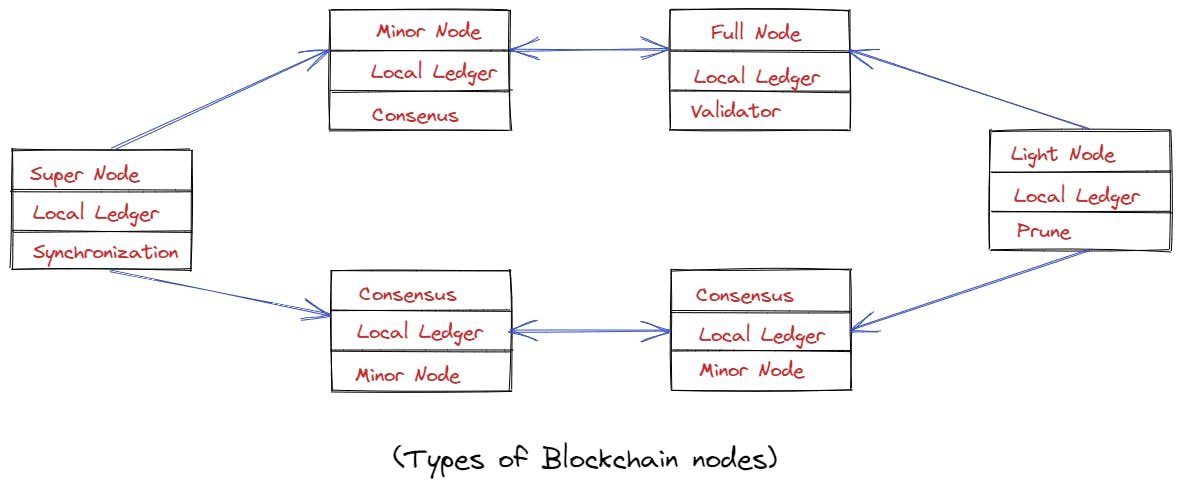So,
I come up with a new topic today and that's nothing but, all about blockchain nodes.
I hope you guys are aware of the Peer-to-Peer(P2P) Network and how the blockchain work. If not please follow these articles before moving forward.
Great!
As you know, the blockchain is a peer-to-peer network, but not all participating nodes have the capability or intent to perform all the functionality to perform all the activities and transactions on nodes. Based on the capability of nodes to perform transactions or activities on blockchain nodes, it is classified in different ways.
Saroj, but we are confusing here.
Cool. let me explain in a simple way :)
Assume you are working in a company with 1000 employees. But, that 1000 employees have some different work right? let's say you are working as a senior dev, someone working as a junior dev. There are many classifications within the company, right? For eg. Manager, HR, Frontend dev, and backend dev.
Like this, there can be many nodes inside a blockchain network, but they all are classified in different ways, like your company :)
Ok Saroj, that's great. Also, can you tell me more about this classification?
Sure, let's try to understand this with an image.

Nodes are classified as
Minor Nodes
Full Nodes
Administrator Nodes
Light-Weight Nodes
I hope now you got some idea about Node classification. Now let us understand it all one by one.
Yes Saroj, Please
1. Minor Nodes
So, what is a Minor Node?
These are nodes that can perform almost all the activities on the blockchain network. These nodes have the full copy of the ledger with them. Minor nodes participate to capture transactions, create or propose blocks, participate in building consensus, and synchronize their ledger copies. Minor nodes are also rewarded if their blocks are added through PoW consensus.
2. Full Nodes
Full nodes store full copies of the ledger ad validate the newly added blocks. These nodes are primarily responsible for the verification of transactions that are created by minors. Mining and consensus are not the same as verification. In the case of mining, blocks are created and as per protocol, blocks are finalized. In verification, blocks are confirmed and then accepted to be part of the ledger. Minor nodes also act as full nodes in a way that they maintain a full ledger and they verify transactions confirmed by other participants. On the other hand, full nodes do not perform the responsibility of the minor nodes.
3. Administrator Nodes
Administrator nodes perform administration activities and support other nodes for certain activities. While blockchain is decentralized and no single party or node can be considered administrators or controllers, there can be situations, especially in the case of a private blockchain that provides higher authority for certain nodes to make decisions such as adding a new node.
Sometimes these nodes are available always and tasked with the responsibility of supporting synchronization activities. These nodes may have unique hardware supporting them based on requirements. Nodes can take the responsibility for archival data. Administration nodes called super nodes are archival nodes depending on the role they play in the network.
4. Light-Weight Nodes
Light-wight nodes do not store the full ledgers but only block headers. These nodes verify transactions. As these nodes do not store the entire ledger, they need lesser resources and are relatively easier to run. Usually, these nodes support end-user applications such as wallets. Light-weight nodes require the help of full nodes to stay up-to-date. These nodes are not mutually exclusive types, meaning a node might perform tasks of multiple noes.
Cool
I know it is kind of a bit confusing if you are new to blockchain. But trust me, once you understand it, it will be fun for you.
I hope you enjoyed the reading.
Again, thanks for reading this out. See you with a new article.
Still have any issues, feel free to connect with me on LinkedIn and Twitter
